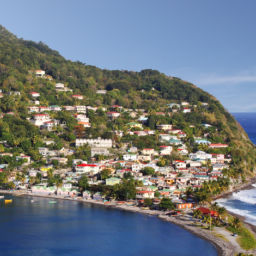By Guest Blogger C. David Conner
The answer is Dominica, my favorite Caribbean island.
I enjoy my surface intervals as much as my time spent underwater, and the self-professed “Nature Island” offers plenty of activities for both pursuits. For this night dive we journeyed from the capital of Roseau in the south to the northwest city of Portsmouth.
Our group consisted of three divers and the local divemaster. We got a late start because of rain, so only a few stray beams lightened a western sky as our jeeps pulled into an empty parking lot. Instead of preparing our gear before sunset as planned, we had to get ready in the dark and used flashlights to do our equipment checks. I like shore diving, but this area features large rocks and boulders strewn about just offshore, so we had to tread with caution over and around these obstacles while contending with the rhythmic waves. I felt like a Navy Seal preparing for a secret operation as lights from anchored boats and the town across the bay sparkled across dark waves.
As soon as the water got deep enough I floated above the rocks and kicked farther from shore until reaching the spot where we did one final check of primary and back-up lights before descending into the depths. Pole-to-Pole is considered an easy pier dive, but what it lacks in challenge it more than makes up for with mesmerizing serenity.
Even though we arrived in Dominica during the ostensibly dry month of May, it rained a lot during our trip. Usually pristine and clear waters had turned turbid with run-off, but this did little to mar the beauty underwater. Night diving isn’t about how far you can see, but rather about what you can see within the beam of the flashlight. We descended down a gentle slope and made our way to the dock’s large support columns jutting up to the surface. This dock used to service smaller cruise ships, but with much larger ships now sailing these waters a larger dock was built just off Roseau in the south. From the absence of empty bottles and other debris, I assumed that not many people come to this area anymore. We didn’t stray far from the dock and our small group stayed close together, yet we were in our own separate areas. A few lights from Ft. Shirley cast diffuse, ghostly shadows around the pier.
After a few minutes I noticed rhythmic flashing from one of the divers scanning the bottom and made my way closer. The divemaster had found a lone cuttlefish swimming out in the open. I have a tendency to call them “cuddlefish” because of my fondness for these intelligent creatures. Classified as cephalopods, they grow between 5 to 9 inches (15 to 25 cm). They have short tentacles, a compact cylindrical body, and a rippling fan-like fin separating their upper and lower halves. This cuttlefish did not let us get too close, but it did not seem concerned by our presence either. Other than the cuttlefish, the only sea life we found was a lobster hiding under the shadow of a rock and a small eel.
This was not my most memorable night dive as far as numbers of fish or variety of species, but it was the culmination of a day of adventure, far from where most people ever get to go. After stowing our gear and changing, it was time for some fresh seafood, live Reggae music and a celebratory Caribbean drink.


